
A Zeppelin is a type of rigid airship named after the German inventor Ferdinand von Zeppelin who pioneered rigid airship development at the beginning of the 20th century. Zeppelin's notions were first formulated in 1874 and developed in detail in 1893. They were patented in Germany in 1895 and in the United States in 1899. After the outstanding success of the Zeppelin design, the word zeppelin came to be commonly used to refer to all forms of rigid airships. Zeppelins were first flown commercially in 1910 by Deutsche Luftschiffahrts-AG (DELAG), the world's first airline in revenue service. By mid-1914, DELAG had carried over 10,000 fare-paying passengers on over 1,500 flights. During World War I, the German military made extensive use of Zeppelins as bombers and as scouts. Numerous bombing raids on Britain resulted in over 500 deaths.

This is a list of aviation-related events from 1915:
This is a list of aviation-related events from 1916:
This is a list of aviation-related events from 1917.

The Birmingham Blitz was the heavy bombing by the Nazi German Luftwaffe of the city of Birmingham and surrounding towns in central England, beginning on 9 August 1940 as a fraction of the greater Blitz, which was part of the Battle of Britain; and ending on 23 April 1943. Situated in the Midlands, Birmingham, the most populous British city outside London, was considered an important industrial and manufacturing location. Around 1,852 tons of bombs were dropped on Birmingham, making it the third most heavily bombed city in the United Kingdom in the Second World War, behind London and Liverpool.

A German air campaign of the First World War was carried out against Britain. After several attacks by seaplanes, the main campaign began in January 1915 with airships. Until the Armistice the Marine-Fliegerabteilung and Die Fliegertruppen des deutschen Kaiserreiches mounted over fifty bombing raids. The raids were generally referred to in Britain as Zeppelin raids but Schütte-Lanz airships were also used.

Essendon is a village and civil parish in Hertfordshire, England, 6 miles (10 km) south-west of Hertford.
The Schütte-Lanz SL 11 was a German military dirigible built in 1916 by Luftschiffbau Schütte-Lanz. It was the first German airship to be shot down while bombing England.

The LZ 61 was a World War I German Navy airship, allocated the tactical numbering 'L 21'. It carried out a total of ten raids on England, and 17 reconnaissance missions.
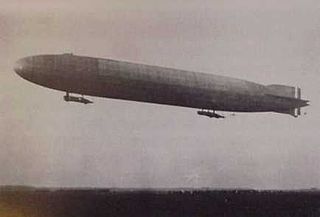
Zeppelin LZ 54, given the military tactical designation L 19, was a Zeppelin of the Imperial German Navy. While returning from her first bombing raid on the United Kingdom in early 1916, she came down in the North Sea. Its crew survived the crash, but drowned after the crew of a British fishing trawler King Stephen refused to rescue them, citing fears that the Germans would overpower them. The incident received worldwide publicity and divided British public opinion, and was used in German propaganda.
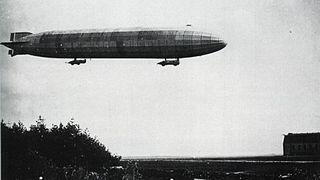
The Zeppelin P Class was the first Zeppelin airship type to be produced in quantity after the outbreak of the First World War. Twenty-two of the type were built as well as twelve of a lengthened version, the Q Class. They were used for many of the airship bombing raids on the United Kingdom in 1915-16, for naval patrol work over the North Sea and Baltic and were also deployed on the eastern and south-eastern fronts.
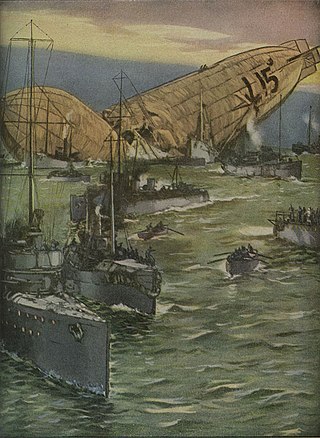
The Imperial German Navy Zeppelin LZ 48 was a P-class World War I zeppelin.

Zeppelin LZ 38 was Zeppelin P Class airship of the German Imperial Army. It was the first to bomb London, United Kingdom.
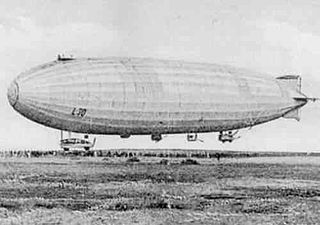
Zeppelin "L 30" was the first R-class "Super Zeppelin" of the German Empire. It was the most successful airship of the First World War with 31 reconnaissance flights and 10 bombing runs carrying a total of 23,305 kg of bombs, with the first ones targeting England, and the four final raids targeting Livonia and Ösel (Saaremaa). At the time of its construction, It was the world's largest Zeppelin, and with its 6 engines, "L 30" could reach speeds higher than 100 km/h, making it the fastest Zeppelin in the world as well.
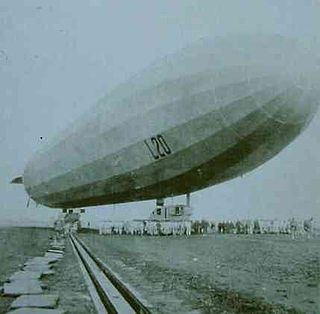
The LZ 59 was a World War I German Navy Airship and was the first Q-Class zeppelin with a then record length of 178.5 metres. It was allocated the tactical numbering L 20 and carried out a total of 19 flights, including 2 raids on England and 10 reconnaissance missions.

The LZ 85, tactical number L 45, also known as Zeppelin of Laragne by the French public, was a World War I R-Class zeppelin of the German Navy that carried out a total of 27 flights, including 3 raids on England and 12 reconnaissance missions.

LZ 72 was an R Class super-zeppelin belonging to the Imperial German Navy. It was commanded by Kapitänleutnant Heinrich Mathy, an experienced commander, and took part in several raids over London during World War I. It also participated in a reconnaissance role during the Sunderland raid of 19 August 1916. Its last flight was launched late at night on 1 October 1916. Several miles north of London, it was caught in searchlights and anti-aircraft fire. During this engagement, 2nd Lt. Wulstan J. Tempest was on patrol and spotted the zeppelin. He proceeded to engage the airship with incendiary rounds, causing the ship to burst into flames and crash in a field near Potter's Bar. The entire crew died, and were originally buried there but were reinterred at Cannock Chase German Military Cemetery in the 1960s. After this disastrous crash, the Imperial German Navy began reducing the number of zeppelin raids.
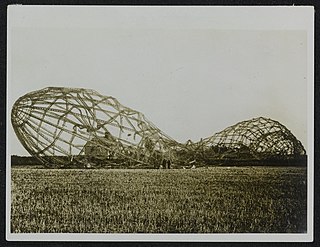
The Imperial German Army Zeppelin LZ 76 (L-m33) was a R-class World War I zeppelin.
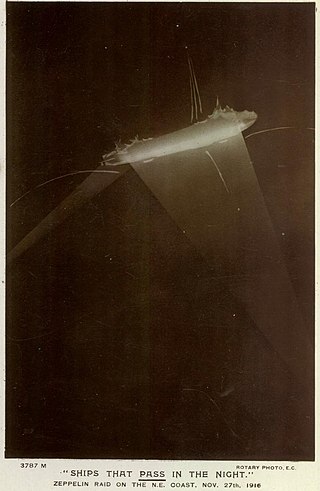
The Imperial German Army Zeppelin LZ 78 (L-34) was a R-class World War I zeppelin.
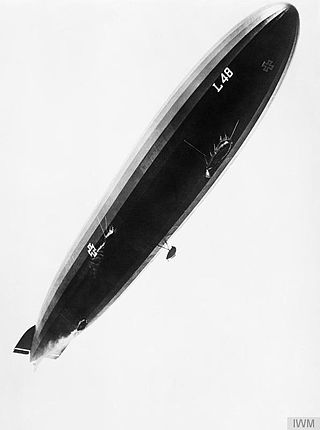
Zeppelin LZ 95 was a U-class zeppelin of the Imperial German Military.



















